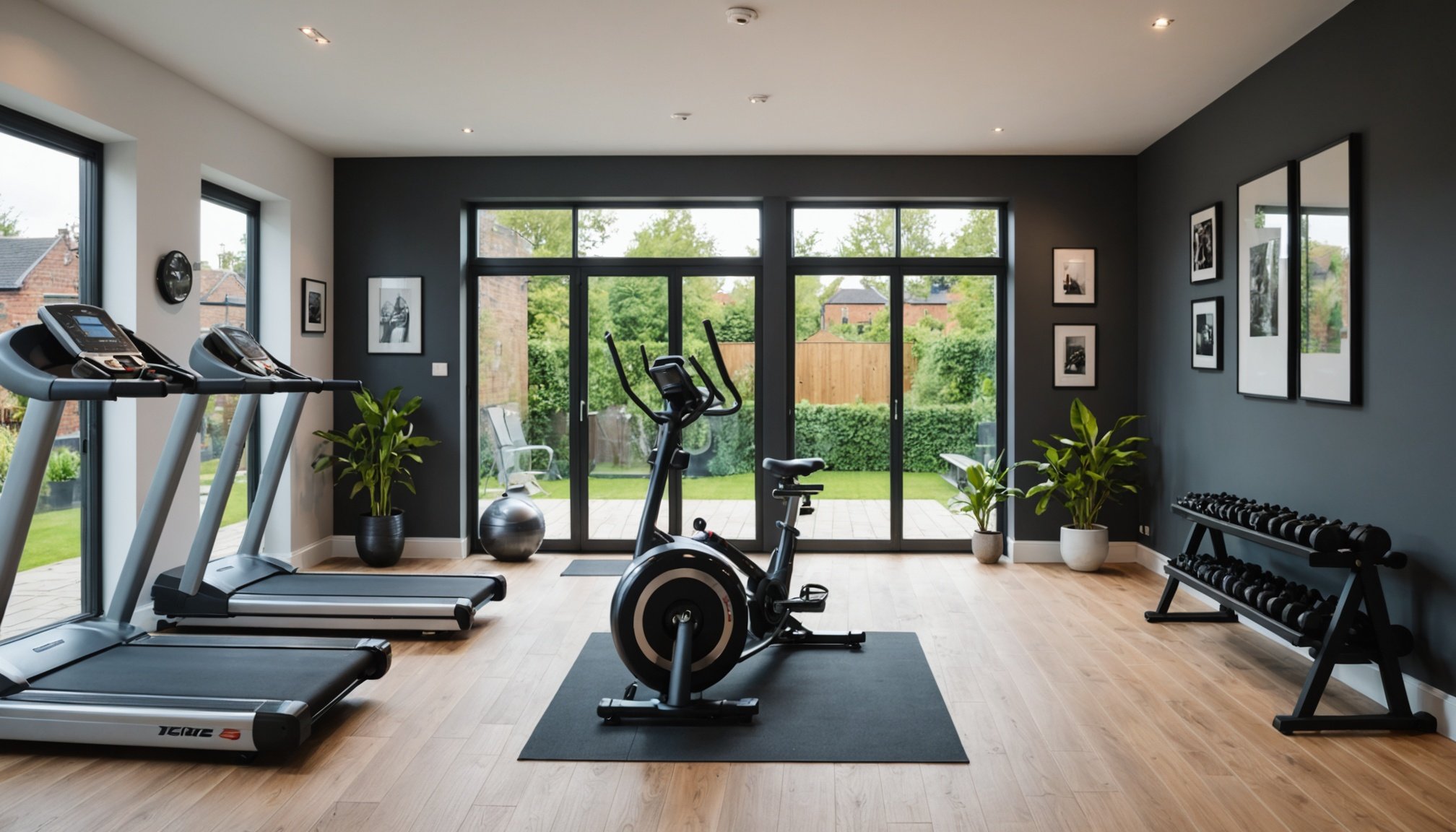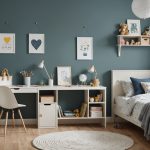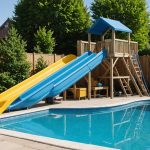Overview of Home Gym Design for Mid-Terrace Houses
Designing a home gym in a UK mid-terrace house presents unique challenges due to the often limited space available. However, with smart planning and creativity, it’s possible to create a functional and aesthetically pleasing gym area.
In mid-terrace homes, every inch counts. The key is to employ space-saving solutions that maximise functionality without overcrowding. Consider folding and compact equipment, such as collapsible benches or wall-mounted resistance bands, which can help in maintaining an uncluttered environment. Multi-functional equipment, like a squat rack that doubles as a pull-up bar, is also beneficial.
A lire aussi : Essential Zoning Factors to Consider for Extending Your Detached Home in the UK
For a mid-terrace home gym, identifying essential elements is crucial. Decide what type of workouts you’ll focus on, whether it’s cardio, strength training, or flexibility exercises. This decision will guide the choice of equipment, ensuring each item serves a specific purpose.
Integrating your gym space with the overall home decor requires careful aesthetic consideration. Opt for a neutral colour palette and minimalistic design to blend the gym with existing interiors. Mirrors can be used strategically to create an illusion of more space, and proper lighting enhances both ambience and safety. By balancing these elements, you can achieve an inviting and efficient home gym design.
A lire aussi : Creative Solutions for Maximizing Space in a UK Three-Bedroom House for Large Families Without Extensions
Creative Space-Saving Solutions
When setting up a home gym, making the most of your space is crucial. One effective strategy is to leverage vertical space with wall-mounted equipment. By attaching items such as pull-up bars and resistance band hooks to walls, floor space remains free and open.
Multi-functional furniture can transform small areas into dynamic workout zones. Consider a folding bench that doubles as seating when not in use or a desk that converts to an exercise bike. This versatility allows for varied workouts while maintaining a tidy environment.
Keeping a gym free from clutter enhances its usability and aesthetics. Clever storage solutions, such as built-in shelves or under-bed storage trays, provide designated spaces for weights, yoga mats, and other essentials. These options not only save space but also make equipment easily accessible.
Ultimately, thoughtfully incorporating these space-saving gym ideas into home interiors promotes a more active lifestyle without compromising on style or function. With creativity and smart planning, any area can become an efficient and inviting exercise haven.
Layout Suggestions for Optimal Use of Space
Creating a gym space that is both effective and inviting requires thoughtful gym layout and functional design.
Zoning Your Gym Area
Zoning is essential in creating a well-organized gym. Begin by dividing the space based on workout types: strength, cardio, and flexibility areas should each have their own designated section. By intentionally zoning your gym area, you create specific places where users can focus on their routines without interference. Additionally, zoning facilitates better traffic flow, ensuring that users can move freely and safely between each activity zone.
Incorporating Natural Light
Incorporating natural light can have a transformative effect on your gym. Natural light not only improves aesthetic appeal but also has been shown to enhance mood and increase energy levels. Position windows strategically to flood exercise areas with light, providing a refreshing environment that makes workouts more enjoyable. If feasible, use mirrors to reflect light, amplifying its presence in the space.
Flow and Accessibility
Ensuring a logical flow and accessibility is pivotal for a functional gym design. Plan for open pathways between equipment to prevent congestion and facilitate easy movement. Ensure that equipment is spaced adequately to avoid accidents and provide easy access for all users, including those with mobility challenges. Such considerations enhance the user experience by creating a safe and efficient workout space.
Equipment Recommendations for Home Gyms
Creating an effective exercise space at home requires careful selection of home gym equipment that caters to your needs and space constraints. For those with limited room, compact fitness gear is invaluable. Consider equipment such as adjustable dumbbells, resistance bands, and folding treadmills, all of which offer dynamic workouts without claiming too much real estate.
Safety is paramount when setting up any home gym. It’s essential to ensure that all equipment is maintained and used as per manufacturer guidelines to prevent injuries. Always allocate adequate space around each piece of equipment to avoid accidents during use.
Selecting gear that aligns with your workout style is key to maintaining motivation and achieving fitness goals. If strength training is your focus, invest in multi-purpose equipment like kettlebells, which can target multiple muscle groups. Cardiovascular enthusiasts might prefer compact options like jump ropes or mini step machines that are easy to store when not in use.
For those concerned about seamless integration, resistance bands are particularly versatile—they can be used in virtually any workout routine and stored easily. By choosing the right combination of equipment, you can create a home gym tailored to your personal fitness journey.
Aesthetic Considerations for a Harmonious Design
Crafting a gym aesthetic that aligns with your interior design vision can transform any workout space into a motivational haven. Creating a harmonious balance between functionality and style is vital.
Colour Schemes and Decor
The colour scheme of your gym should inspire energy and motivation. Opt for vibrant hues like oranges and reds to stimulate activity or serene blues and greens to promote calm focus. Décor elements, such as artwork or mirrors, can enhance light and add personality to your space. Mirrors are particularly beneficial—they create the illusion of space and assist in perfecting form during exercises.
Flooring Options
Choosing the right flooring is crucial for both comfort and functionality. Durable options like rubber provide cushioning, reducing the risk of injury, while laminate or vinyl offers easy maintenance. Consider soundproofing features if your gym is above a living area in your mid-terrace house.
Inspirational Design Examples
Successful gym designs, particularly in UK mid-terrace houses, prioritize efficient use of space. Clever storage solutions maintain a clutter-free environment, enhancing the overall gym aesthetic. Lighting choices play a pivotal role, with natural light preferred to bring warmth and energy to the setting.
Cost Considerations for Setting Up a Home Gym
Creating a home gym does not have to break the bank. With thoughtful planning, you can achieve a budget-friendly setup without compromising on quality. First, assess your fitness goals and prioritize the equipment that aligns with them. This strategic approach is key to managing home gym costs effectively.
Budgeting Tips: Begin by deciding on the available budget, taking into account both immediate spending and potential long-term savings. Opt for cost-effective alternatives like resistance bands, used dumbbells, or adjustable weights, which often provide similar functionality to pricier counterparts.
Additionally, platforms like Craigslist or Facebook Marketplace can offer used equipment at a fraction of the cost. Keep an eye out for multigym equipment that combines multiple exercises into one unit, maximizing your space and investment.
Evaluating long-term savings vs. upfront investment is crucial too. Although the initial expenditure may seem daunting, owning equipment can eliminate monthly gym membership fees, offering a return on investment over time. Furthermore, home setups save on travel time, granting more convenience and consistency in your routine.
By being mindful of these strategies, setting up a home gym becomes an attainable goal, offering physical health benefits along with potential financial savings in the long run.
Successful Examples of Mid-Terrace Home Gyms
Setting up a home gym in a mid-terrace UK home is no small feat, given the space constraints. Yet, homeowners have creatively turned these challenges into opportunities. Let us explore some successful real home gym examples and understand the factors contributing to their triumphs.
Take the case of a homeowner who brilliantly repurposed their spare room. By focusing on multi-functional equipment like foldable benches and adjustable dumbbells, they succeeded in creating a real home gym without clutter. This approach maximises space without compromising on workout variety, a strategy lauded by many in similar situations.
Another example involves transforming an underused corner into a dedicated workout zone. Installing mirrors not only enhanced the sense of space but also helped in perfecting exercise postures. This setup showcases how careful consideration of personal tastes and preferences can transform a space efficiently.
Lessons learned from these examples include prioritising essential equipment like resistance bands or a compact treadmill. Additionally, natural light and ventilation were noted to have a substantial impact on usability and motivation. These insights become critical for those looking to optimise their mid-terrace homes in the UK into effective workout spaces.











